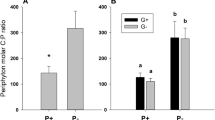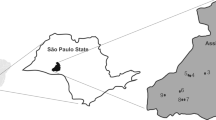Abstract
The effects of grazing by stream invertebrates on algal biomass and spatial heterogeneity were tested experimentally in flow-through microcosms with natural substrates (rocks). One experiment tested the effects of fixed densities of three species of grazers (the caddisfly Allomyia sp. and two mayflies, Epeorus deceptivus and Baetis bicaudatus) on periphyton. Baetis was tested with and without chemical cues from fish predators, which reduced grazer foraging activity to levels similar to the less mobile mayfly (Epeorus). Mean algal biomass (chlorophyll a; chl a) was reduced in grazer treatments compared to ungrazed controls, but there were no differences among grazer treatments. Algal heterogeneity (Morisita index) increased with grazer mobility, with the highest heterogeneity occurring in the Baetis-no fish treatment (most mobile grazer) and the lowest in the caddisfly treatment (most sedentary grazer). A second experiment used a three factorial design, and tested whether initial resource distribution (homogeneous vs. heterogeneous), Baetis density (high vs. low) and fish odor (present vs. absent) affected grazer impact on algal resources. Abundances of Baetis and chl a on individual rocks were recorded to explore the mechanisms responsible for the observed distributions of algae. Initial resource heterogeneity was maintained despite being subjected to grazing. Mean chl a was highest in controls, as in experiment I, and effects of Baetis on algal biomass increased with grazer density. There were no fish effects on algal biomass and no effects of grazer density or fish on algal heterogeneity. At the scale of individual rocks Baetis was unselective when food was homogeneously distributed, but chose high-food rocks when it was heterogeneously distributed. Results of these mechanistic experiments showed that Baetis can track resources at the scale of single rocks; and at moderate densities mobile grazers could potentially maintain periphyton distributions observed in natural streams.






Similar content being viewed by others
References
Abrams PA (2000) The impact of habitat selection on the spatial heterogeneity of resources in varying environments. Ecology 81:2902–2913
Adler PB, Raff DA, Lauenroth WK (2001) The effect of grazing on the spatial heterogeneity of vegetation. Oecologia 128:465–479
Bailey DW, Gross JE, Laca EA, Rittenhouse LR, Coughenour MB, Swift DM, Sims PL (1996) Mechanisms that result in large herbivore grazing distribution patterns. J Range Manage 49:386–400
Bakker C, Blair JM, Knapp AK (2003) Does resource availability, resource heterogeneity or species turnover mediate changes in plant species richness in grazed grasslands? Oecologia 137:385–391
Berlow EL, Navarrete SA, Briggs CJ, Power ME, Menge BA (1999) Quantifying variation in the strengths of species interaction. Ecology 80:2206–2224
Bigger DS and Marvier MA (1998) How different would a world without herbivory be? A search for generality in ecology. Integr Biol 1:60–67
Biggs BJF (1996) Patterns in benthic algae of streams. In: Stevenson RJ, Bothwell ML, Lowe RL (eds) Algal ecology: freshwater benthic ecosystems. Academic Press, San Diego, Calif., pp 31–56
Bisigato AJ, Bertiller MB (1997) Grazing effects on patchy dry land vegetation in northern Patagonia. J Arid Environ 36:639–653
Bronmark C, Klosiewski SP, Stein RA (1992) Indirect effects of predation in a freshwater, benthic food chain. Ecology 73:1662–1674
Carpenter SR (1996) Microcosms have limited relevance for community and ecosystem ecology. Ecology 77:677–680
Chase JM, Wilson W, Richards S (2001) Foraging trade-offs and resource patchiness: theory and experiments with a freshwater snail community. Ecol Lett 4:304–312
Cooper SD, Diehl S, Kratz S, Sarnelle O (1998) Implications of scale for patterns and processes in stream ecology. Aust Ecol 23:27–40
Cyr H, Pace ML (1993) Magnitude and patterns of herbivory in aquatic and terrestrial ecosystems. Nature 361:148–150
Dudley TL (1992) Beneficial effects of herbivores on stream macroalgae via epiphyte removal. Oikos 65:121–127
Duffy JE, Macdonald KS, Rhode JM, Parker JD (2001) Grazer diversity, functional redundancy, and productivity in seagrass beds: an experimental test. Ecology 82:2417–2434
Edmunds GF, Jensen SL, Berner L (1976) The mayflies of North and Central America. University of Minnesota Press, Minneapolis, Minn.
Elliott JM (1977) Some methods for the statistical analysis of samples of benthic invertebrates. Freshwater Biol Assoc Sci Publ 25:50–79
Englund G (1997) Importance of spatial scale and prey movements in predator caging experiments. Ecology 78:2316–2325
Feminella JW, Resh VH (1990) Hydrologic influences, disturbance, and intraspecific competition in a stream caddisfly population. Ecology 71:2083–2094
Feminella JW, Power ME, Resh VH (1989) Periphyton response to grazing invertebrates and riparian canopy in three northern California coastal streams. Freshwater Biol 22:445–457
Flecker AS (1997) Habitat modification by tropical fishes: environmental heterogeneity and the variability of interaction strength. J North Am Benthol Soc 16:286–295
Flecker AS, Taylor BW (2004) Tropical fishes as biological bulldozers: density effects on resource heterogeneity and species diversity. Ecology 85:2267–2278
Forrester GE (1994) Influences of predatory fish on the drift dispersal and local density of stream insects. Ecology 75:1208–1218
Gelwick FP (2000) Grazer identity changes the spatial distribution of cascading trophic effects in stream pools. Oecologia 125:573–583
Gelwick FP, Matthews WJ (1997) Effects of algivorous minnows (Campostoma) on spatial and temporal heterogeneity of stream periphyton. Oecologia 112:386–392
Hildrew AG (1996) Food webs and species interactions. In: Petts GE, Calow P (eds) River biota, diversity and dynamics. Blackwell, Oxford, pp 123–144
Hill WR, Knight AW (1987) Experimental analysis of the grazing interaction between a mayfly and stream algae. Ecology 68:1955–1965
Hill WR, Knight AW (1988) Concurrent grazing effects of two stream insects on periphyton. Limnol Oceanogr 33:15–26
Hill WR, Weber SC, Stewart AJ (1992) Food limitation of two lotic grazers: quantity, quality, and size-specificity. J North Am Benthol Soc 11:420–432
Hobbs NT, Gross JE, Shipley LA, Spalinger DE, Wunder BA (2003) Herbivore functional response in heterogeneous environments: a contest among models. Ecology 84:666–681
Knapp AK, Blair JM, Briggs JM, Collins SL, Hartnett DC, Johnson LC, Towne EG (1999) The keystone role of bison in North American tallgrass prairie. BioScience 49:39–50
Kohler SL (1984) Search mechanism of a stream grazer in patchy environments: the role of food abundance. Oecologia 62:209–218
Kohler SL (1985) Identification of stream drift mechanisms: an experimental and observational approach. Ecology 66:1749–1761
Kohler SL, Wiley MJ (1997) Pathogen outbreaks reveal large-scale effects of competition in stream communities. Ecology 78:2164–2176
Laca EA, Demment M (1991) Herbivory: the dilemma of foraging in a spatially heterogeneous food environment. In: Palo RT, Robbins CT (eds) Plant defenses against mammalian herbivory. CRC, Boca Raton, Fla., pp 29–44
Lamberti GA, Ashkenas LR, Gregory SV, Steinman AD (1987) Effects of three herbivores on periphyton communities in laboratory streams. J North Am Benthol Soc 6:92–104
Lamberti GA, Gregory SV, Ashkenas LR, Li JL, Steinman AD, McIntire CD (1995) Influences of grazer type and abundance on plant-herbivore interactions in streams. Hydrobiologia 306:179–188
Laska MS, Wootton JT (1998) Theoretical concepts and empirical approaches to measuring interaction strength. Ecology 79:461–476
Levin SA (1992) The problem of pattern and scale in ecology. Ecology 73:1943–1967
Lubchenco J (1978) Plant species diversity in a marine intertidal community: importance of herbivore food preference and algal competitive abilities. Am Nat 112:23–39
McIntosh AR, Townsend CR (1996) Interactions between fish, grazing invertebrates and algae in a New Zealand stream: a trophic cascade mediated by fish-induced changes to grazer behavior. Oecologia 108:174–181
McIntosh AR, Peckarsky BL, Taylor BW (2004) Predator-induced resource heterogeneity in a stream food web. Ecology 85:2279–2290
McPeek MA, Peckarsky BL (1998) Life histories and the strengths of species interactions: combining mortality, growth, and fecundity effects. Ecology 79:867–879
Mills LS, Soule ME, Doak DF (1993) The keystone species concept in ecology and conservation. BioScience 43:219–224
Miyasaka H, Genkai-Kato M, Kuhara N, Nakano S (2003) Predatory fish impact on competition between stream insect grazers: a consideration of behaviorally- and density-mediated effects on an apparent coexistence pattern. Oikos 101:511–520
Mulholland PJ, Steinman AD, Palumbo AV, Elwood JW (1991) Role of nutrient cycling and herbivory in regulating periphyton communities in laboratory streams. Ecology 72:966–982
Nusch EA (1980) Comparison of different methods for chlorophyll and phaeopigments. Arch Hydrobiol Beih Ergebg Limnol 14:14–36
Osenberg CW, Mittelbach GG (1996) The relative importance of resource limitation and predator limitation in food chains. In: Polis GA, Winemiller KO (eds) Food webs: integration of patterns and dynamics. Chapman and Hall, New York, pp 134–148
Peckarsky BL (1991) Habitat selection by stream-dwelling predatory stoneflies. Can J Fish Aquat Sci 48:1069–1976
Peckarsky BL (1996) Alternative predator avoidance syndromes in stream-dwelling mayflies. Ecology 77:1888–1905
Peckarsky BL, Cowan CA (1991) Consequences of larval intraspecific interference to stonefly growth and fecundity. Oecologia 88:277–288
Peckarsky BL, Cowan CA (1995) Microhabitat and activity periodicity of predatory stoneflies and their mayfly prey in a western Colorado stream. Oikos 74:513–521
Peckarsky BL, McIntosh A (1998) Fitness and community consequences of avoiding multiple predators. Oecologia 113:565–576
Peckarsky BL, Cooper SD, McIntosh AR (1997) Extrapolating from individual behavior to populations and communities in streams. J North Am Benthol Soc 16:375–390
Peckarsky BL, Taylor BW, McIntosh AR, McPeek MA, Lytle DA (2001) Variation in mayfly size at metamorphosis as a developmental response to risk of predation. Ecology 82:740–757
Poff NL, Nelson-Baker K (1997) Habitat heterogeneity and algal grazer interactions in streams: explorations with a spatially explicit model. J North Am Benthol Soc 16:263–276
Power ME (1984) Habitat quality and the distribution of algae-grazing catfish in a Panamanian stream. J Anim Ecol 53:357–374
Power ME (1990) Resource enhancement by indirect effects of grazers: armored catfish, algae, and sediment. Ecology 71:897–904
Richards C, Minshall GW (1988) The influence of periphyton abundance on Baetis bicaudatus distribution and colonization in a small stream. J North Am Benthol Soc 7:77–86
Sarnelle OK, Kratz W, Cooper SD (1993) Effects of an invertebrate grazer on the spatial arrangement of a benthic microhabitat. Oecologia 96:208–218
Scheiner SM (2001) MANOVA: multiple response variables and multispecies interactions. In: Scheiner SM, Gurevitch J (eds) Design and analysis of ecological experiments. Oxford University Press, New York, pp 99–115
Sih A, Wooster D (1994) Prey behavior, prey dispersal and predator impacts on stream prey. Ecology 68:1199–1207
Sommer U (2000) Benthic microalgal diversity enhanced by spatial heterogeneity of grazing. Oecologia 122:284–287
Steinman AD (1996) Effects of grazers on freshwater benthic algae. In: Stevenson RJ, Bothwell ML, Lowe RL (eds) Algal ecology: freshwater benthic ecosystems. Academic Press, San Diego, Calif., pp 341–373
Steinman AD, McIntire CD, Gregory SV, Lamberti GA, Ashkenas LR (1987) Effects of herbivore type and density on taxonomic structure and physiognomy of algal assemblages in laboratory streams. J North Am Benthol Soc 6:175–188
Taylor BW, McIntosh AR, Peckarsky BL (2002) Reach-scale invertebrate manipulations show invertebrate grazers depress algal resources in natural streams. Limnol Oceanogr 47:893–899
Wiggins GB (1996) Larvae of the North American caddisfly genera, 2nd edn. University of Toronto Press, Toronto
Wolcott DL, O’Connor NJ (1992) Herbivory in crabs: adaptations and ecological considerations. Am Zool 32:370–381
Wooster D (1994) Predator impacts on stream benthic prey. Oecologia 99:7–15
Wootton JT (1997) Estimates and test of per capita interaction strength: diet, abundance, and impact of intertidally foraging birds. Ecol Monogr 67:45–64
Acknowledgements
We are especially grateful to Wendy Brown, Andrea Encalada, Matt Harper, Bryan Horn, Ben Koch, Brad Taylor and Mark Wallin (“the Benthettes”), for their field and laboratory assistance at the Rocky Mountain Biological Laboratory. Special thanks to Barbara Downes for invaluable statistical advice. Comments by Angus McIntosh, Brad Taylor, Bernhard Statzner and an anonymous reviewer greatly improved the manuscript. Discussion with some members of the Entomology and Evolution Department from Cornell University also provided insight on data interpretation. We also thank LeeAnne Martinez for building the floating raft. Fellowships from the Spanish Education Council (MCYT), Xunta de Galicia and Caixanova supported Maruxa Álvarez during the summers of 2002 and 2003 at RMBL, and NSF Award no. DEB 00-89863 to B. L. P. provided funds for equipment, supplies and field assistants. The authors of this manuscript declare that the experiments conducted throughout this study comply with the current USA laws.
Author information
Authors and Affiliations
Rights and permissions
About this article
Cite this article
Álvarez, M., Peckarsky, B.L. How do grazers affect periphyton heterogeneity in streams?. Oecologia 142, 576–587 (2005). https://doi.org/10.1007/s00442-004-1759-0
Received:
Accepted:
Published:
Issue Date:
DOI: https://doi.org/10.1007/s00442-004-1759-0




